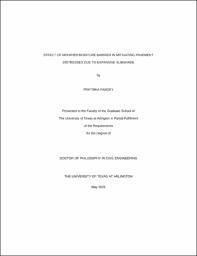
ATTENTION: The works hosted here are being migrated to a new repository that will consolidate resources, improve discoverability, and better show UTA's research impact on the global community. We will update authors as the migration progresses. Please see MavMatrix for more information.
Show simple item record
| dc.contributor.advisor | Hossain, MD Sahadat | |
| dc.creator | Pandey, Pratibha | |
| dc.date.accessioned | 2021-06-01T20:41:25Z | |
| dc.date.available | 2021-06-01T20:41:25Z | |
| dc.date.created | 2021-05 | |
| dc.date.issued | 2021-05-07 | |
| dc.date.submitted | May 2021 | |
| dc.identifier.uri | http://hdl.handle.net/10106/29814 | |
| dc.description.abstract | Surficial distresses in roadways of Texas are very common due to presence of high plastic clayey soil in the subgrade. Increased sensitivity of high plastic clay towards seasonal moisture change results in repeated swelling and shrinkage, and ultimately the development of pavement cracks. Annual expenses of such distresses impose huge financial liability to maintenance authorities. Studies have indicated rainwater intrusion into underlying expansive subgrade soil coupled with inadequate drainage as the main cause of pavement damage in semi-arid regions. The inability of drainage layer to laterally drain the excess moisture may lead to moisture accumulation within the base layer which can also be a source of water for the subgrade soil which tends to swell and shrink periodically. This indicates the need for a cost effective and reliable method to prevent the moisture intrusion into the pavement system using appropriate mechanism.
Among several types of moisture barrier system, Modified Moisture Barrier (MMB) placed at base-subgrade interface offers a promising potential in isolating the subgrade soil from changing climatic conditions. Additionally, the geocomposite component of MMB can enhance the pavement drainage thereby reducing the detrimental effect of moisture on pavements. The previous usage of modified moisture barrier is limited to the edge of pavement with the main aim of controlling moisture intrusion from the edge. However, the study does not take into account the moisture infiltration that may occur from pavement surface along fine cracks formed by ageing and wearing of asphalt. Therefore, the main objective of this study is to evaluate the effectiveness of modified moisture barrier when placed throughout the width of an actual compromised pavement section. For this, a compromised pavement section in Frost, Texas was selected. Two sections were considered- one with the barrier and other without barrier to compare the performance of pavement system. The field performance of pavement sections was regularly monitored using integrated moisture/temperature sensors and horizontal inclinometer.
The performance monitoring results indicated seasonal moisture variation as well as temporary response to rainfall events in control section. In contrast, equilibrium moisture content was recorded by the sensors in barrier section. The results from the moisture sensors were reflected on the deformation results from inclinometer. The use of modified moisture barrier was able to reduce the swelling and shrinkage by 89%. Field data-based prediction models were developed for the control section by analyzing the moisture and deformation trend observed in the field. The model was further validated with other field studies from North Texas for its wide applicability. The effects of both the rainfall and temperature were incorporated in the model. The performance of the subgrade was further evaluated through numerical study where the model was first calibrated and analysis on the swell potential at different dry and wet initial condition was performed. In addition, flow evaluation along the geocomposite component of MMB in response to several rainfall intensities was studied in SEEP/W. Parametric study was conducted to evaluate the effect of different transmissivity of geocomposite in laterally draining infiltrated rainwater out of the system. | |
| dc.format.mimetype | application/pdf | |
| dc.language.iso | en_US | |
| dc.subject | Expansive soil | |
| dc.subject | Pavements | |
| dc.subject | Modified moisture barrier | |
| dc.subject | Numerical modeling | |
| dc.subject | Prediction models | |
| dc.subject | High plastic clay | |
| dc.subject | Climatic loading | |
| dc.subject | Fourier series | |
| dc.title | EFFECT OF MODIFIED MOISTURE BARRIER IN MITIGATING PAVEMENT DISTRESSES DUE TO EXPANSIVE SUBGRADE | |
| dc.type | Thesis | |
| dc.degree.department | Civil Engineering | |
| dc.degree.name | Doctor of Philosophy in Civil Engineering | |
| dc.date.updated | 2021-06-01T20:41:26Z | |
| thesis.degree.department | Civil Engineering | |
| thesis.degree.grantor | The University of Texas at Arlington | |
| thesis.degree.level | Doctoral | |
| thesis.degree.name | Doctor of Philosophy in Civil Engineering | |
| dc.type.material | text | |
| dc.creator.orcid | 0000-0001-8908-1326 | |
Files in this item
- Name:
- PANDEY-DISSERTATION-2021.pdf
- Size:
- 7.637Mb
- Format:
- PDF
This item appears in the following Collection(s)
Show simple item record


